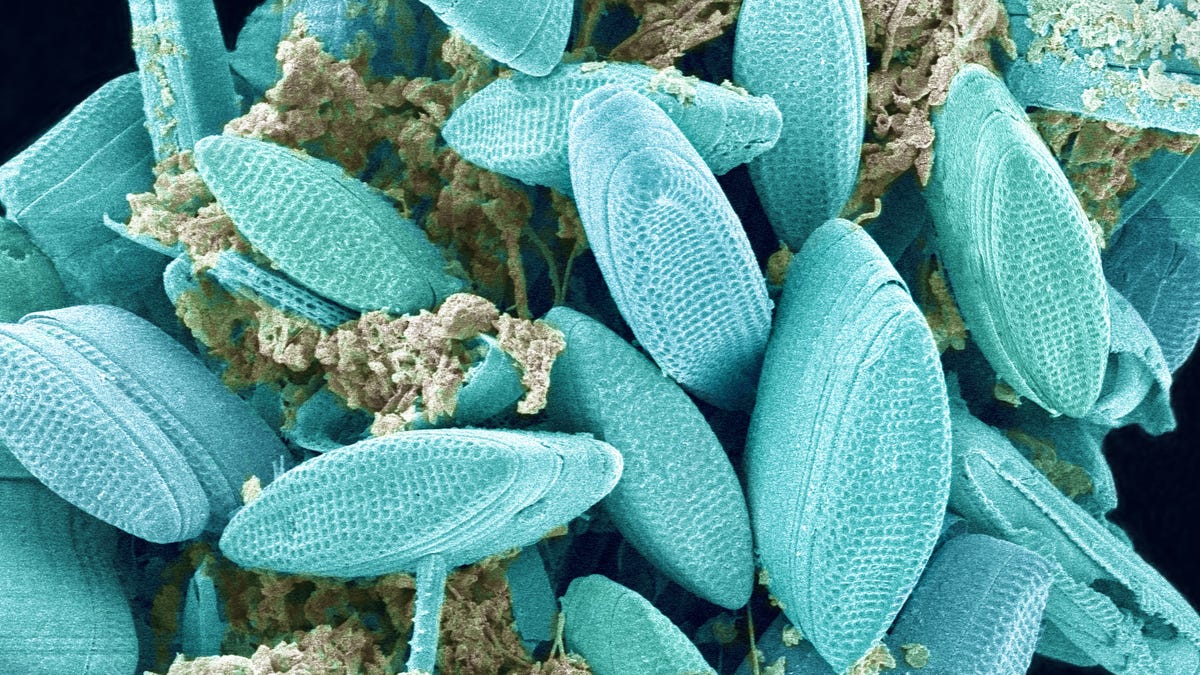Microscopic Life is Blooming Beneath Antarctica's Sea Ice, Surprising Scientists
Blooms of microscopic organisms were detected before the ice retreated for the summer, hinting at hidden ecosystems.

Diatoms, a group of phytoplankton, are hardy organisms that might be thriving under sea ice in Antarctica
Winters in the frigid depths of Antarctica are desolate. The sun disappears for months on end, and the continent becomes surrounded by a ring of sea ice, extending out into the Southern Ocean. But even these extreme conditions, scientists are learning, are no match for life.
In a new study, published Thursday in the journal Frontiers in Marine Science, scientists suggest one of the most critical organisms in the Antarctic food web — microscopic phytoplankton like algae and bacteria — are thriving underneath sea ice.
Many different species of phytoplankton are photosynthetic: They require sunlight to generate energy. When the ocean freezes over, less light can penetrate to the surface where they typically thrive. Scientists have been studying when and where the tiny organisms begin to flourish and have noted this typically occurs when the sea ice retreats. In recent years, work at the opposite end of the world, in the Arctic, has suggested masses of phytoplankton (or "blooms") can and do survive under sea ice in darker, low light conditions.
The same may be true in Antarctica.
In the study, scientists collected data from 51 floating laboratories ("floats") deployed between 2014 and 2021. The floats can gather biogeochemical signals across the Southern Ocean with a suite of sensors and they can also detect sea ice and dive below the surface, drifting through the water.
Looking at the amount of chlorophyll molecules detected by the floats and comparing with NASA satellite determinations of sea ice cover, the researchers described plentiful blooms of phytoplankton living below the sea ice, typically before it retreats during the polar summer. This was true for about 26% of the measurements made.
This, they note, could signal there is a whole hidden ecosystem lurking there that has typically not been accounted for. And if the phytoplankton, which form the basis of the food web, are hiding out under the ice, then we may be underestimating the amount of life hiding out there.
"The more we seem to look under Antarctic sea and land ice the more we seem to find," said Christopher Horvat, a polar oceanographer at Brown University and the University of Auckland and first author of the study.
Are there ecosystems hidden beneath Antarctic ice?
However, Horvat notes, the floats do not provide exact locations when sea ice is present. Instead, they broadcast positions when they return to the surface, leaving some uncertainty in whether the blooms happen underneath or in more open areas of the ocean.
The natural question, perhaps, is what happens to these blooms as climate change sees sea ice retreating earlier and earlier. It's too early to tell, in the Antarctic, but some earlier research in the Arctic is beginning to suggest human-driven warming could affect blooms under sea ice in the north.
"To know if these populations are resilient to climate change we need to know if these events are new or if they were happening before, how often they happen, which species are blooming, understand the physiology of these species and what are the physic-chemical conditions that allow these blooms to form," said Antonia Cristi, a marine ecologist at New Zealand's National Institute of Water and Atmospheric Research.
Future research using different under-ice data collection methods or year-round ship deployment could determine exactly where the phytoplankton blooms are occurring and how much of this is happening under the sea ice. It wouldn't be unexpected to find life adapted to some of the most extreme conditions on Earth — previous finds show we've barely scratched the surface.
For instance, in 2021, the British Antarctic Survey drilled a hole in the Filchner-Ronne Ice Shelf and found unusual lifeforms at a depth of around 4,000 feet. And this past June, New Zealand scientists working at another ice shelf, Ross, melted a hole and found a river of life lurking beneath the shelf, some 1,600 feet down.
Yes, Jurassic Parks fans. Life does indeed find a way. Even in the dark, cold seas of Antarctica.

